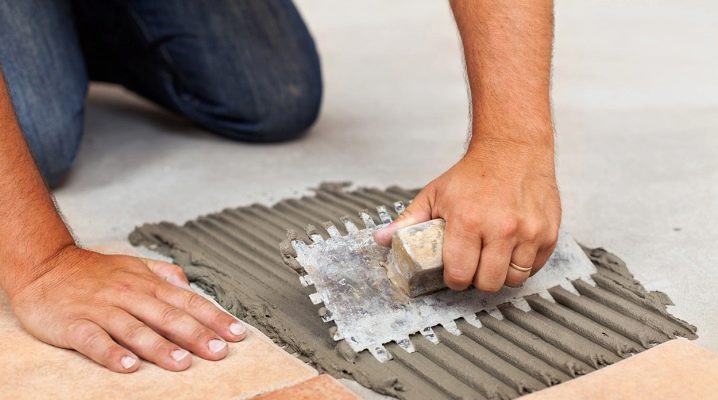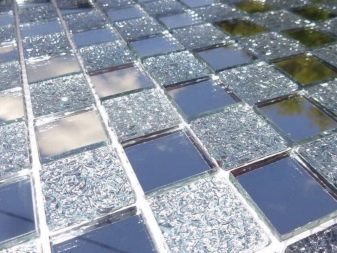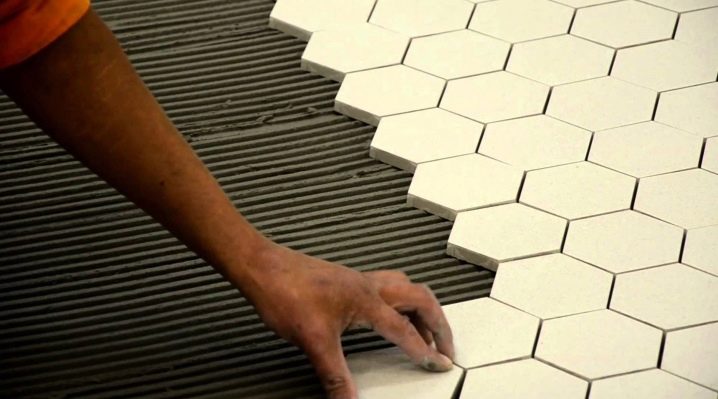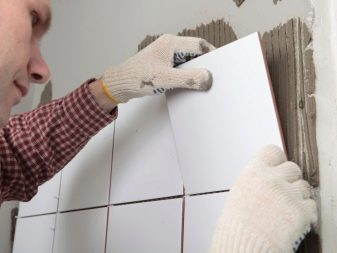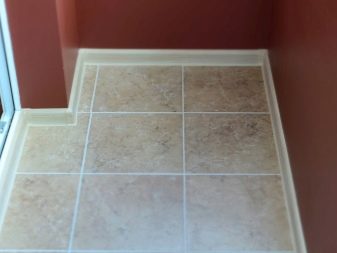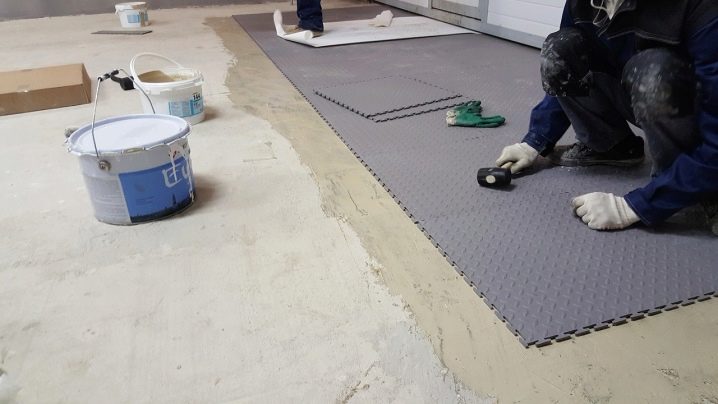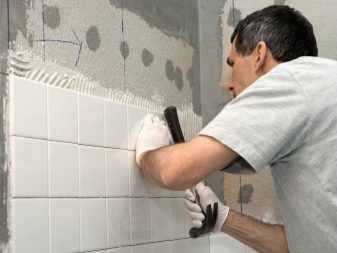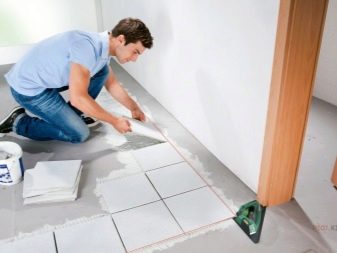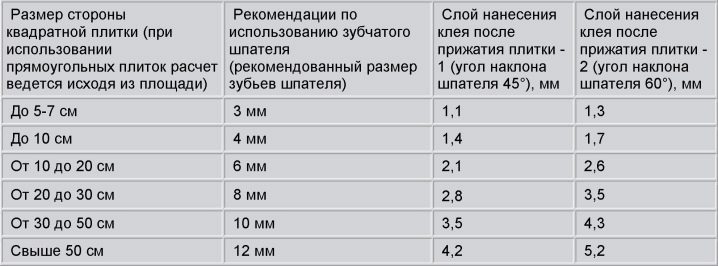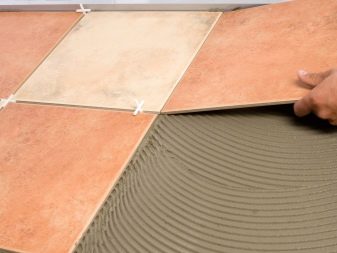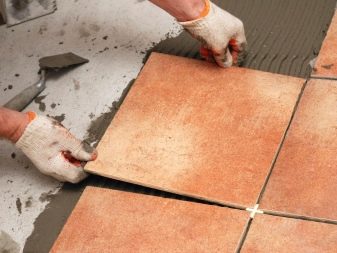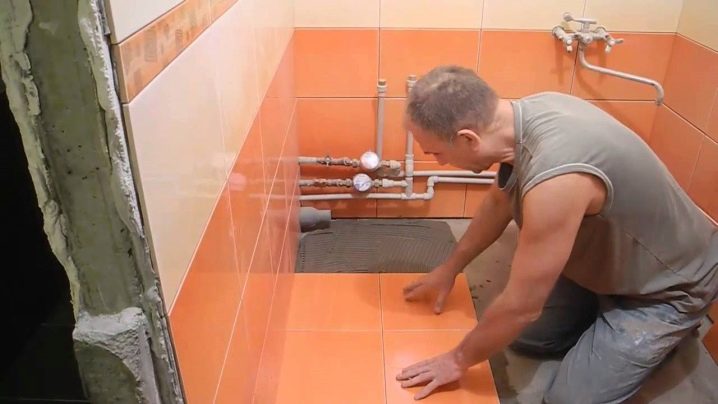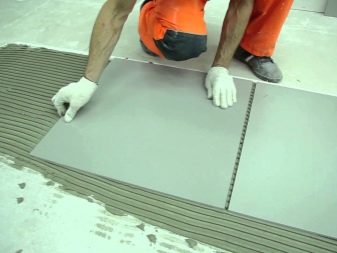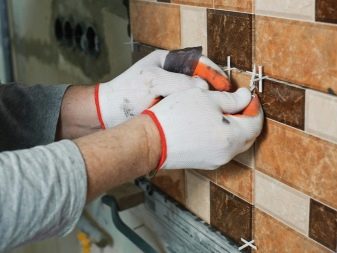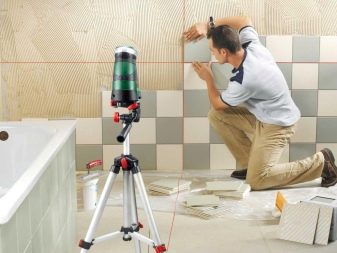Glue consumption for tiles per 1 m2: calculation details
One of the most popular facing materials for the bathroom, kitchen or exterior facade is tile. Whatever type of tile is chosen for repairs, in any case, to fix it on the surface, you need a special tile adhesive. This article will explain in detail how to correctly calculate the consumption of adhesive for each specific type of tile and the surface of walls or floor.
Types of adhesives
First you should get acquainted with the types of glue that are suitable for fixing tiles on the surface of walls or floors. The properties of each particular adhesive solution will directly affect its consumption rates during operation. Adhesive compositions are divided into three main types depending on the component on the basis of which the adhesive solution is made:
- Glue solutions based on sand and cement. This species is the most popular and affordable. This adhesive composition is quite versatile, can be used for exterior and interior decoration. In addition to the sand-cement mixture, plasticizers were added to the adhesive.
For tiles of large size or large mass, such as clinker, a high consumption of this type of glue will be required.
The adhesive composition is most often sold as a dry powder that needs to be diluted with water. The minimum packing in a bag from 5 kilograms.
- Mixtures based on epoxy resins. Contains hardeners and epoxy resin. These two components are mixed in the required ratio immediately before starting work. This adhesive composition has a transparent appearance, so it can be used when laying glass tiles. Epoxy adhesive has high moisture resistance and strength.
As well as the cement composition, it is suitable for both interior decoration and facade finishing.
- Polymer adhesive solution. Sold in the form of a finished composition in containers of various sizes. This glue is very plastic, quickly seizes and securely fixes tiles of any size.Due to these properties has an economical rate of consumption rate. However, due to the relatively high cost compared to other types of glue, polymer glue is less popular.
What affects the consumption
There are a lot of factors that influence the rate of glue consumption per tile per 1 m2. And if counting the squares of the surface area is not difficult, then the calculation of the consumption of glue will require the collection of some data. For the most accurate and correct calculation, it is necessary to take them all as objectively and correctly as possible:
- Type and size of tile or tile chosen for decoration. Each material has a different degree of porosity and density. In the calculation of the flow of glue, this is important, since different types of tiles are in contact with it when applying the adhesive composition.
More porous tile will absorb more glue. Dense material, such as porcelain, practically does not absorb moisture due to its high density. But the matte tile is the most expensive in terms of the amount of adhesive solution per 1 m2.
It is also necessary to pay attention to the structure of the back surface of the tile. The consumption of glue increases in the presence of a large number of irregularities, depressions or chips.
The size of the tile plates also plays a big role.The larger the tile, the greater its mass. Therefore, it will be necessary to apply a larger amount of glue to better fix the tile to the surface.
- Surface featureson which laying is made. As in the case with the back of the tile itself, the amount of the applied adhesive depends on the degree of uniformity and flatness of the wall or floor surface. Swings, protrusions, cracks will require additional consumption of the composition. If the wall or floor relief is substantially non-uniform, it is advisable to level the surface before laying the cladding material.
The secret is in the correct location of the spatula relative to the surface. The greater the angle, the more excess glue will be applied. The optimum angle of the spatula is approximately 40-45 degrees.
- External conditions during the work. This factor is especially important in changing weather conditions, if the work is carried out on the street. If indoors in most cases it is quite possible to maintain constant and optimal conditions for the work, then when working with a facade you will have to adjust to external factors independent of the master.
It should also be borne in mind that a much smaller amount of glue is needed for a concrete surface than for a more porous brick base or a plastered surface. The surface of PVC is also cost-effective in terms of the amount of glue. When calculating the flow of glue solution will need to take into account this feature.
- Method and technology of laying ceramic tiles or tiles. If the facing material is laid in straight rows, the cost of glue will be significantly lower. When laying panels, mosaics, patterns, the consumption of adhesive composition increases.
- The technology of applying the adhesive composition. Experienced masters have a good command of the most economical in terms of glue consumption, the methods of applying the solution. Moreover, the reduction of consumption occurs not to the detriment of the fastening strength of the tile itself.
It is impossible to carry out laying at a temperature below +5 degrees. The dehumidification also affects the quality of work. Too hot temperature is also unacceptable. The maximum threshold at which it is possible to produce high-quality lining is +35 degrees.
If these recommendations are not followed, for example, when working in rainy cold weather, or, conversely, under the scorching sun, there is almost a 100% chance that the glue will simply lose its properties.High-quality fixing tiles on the surface, especially vertical, will be impossible. When the temperature is too high, the glue starts to harden even before the application, the time of using the ready-made mortar is significantly reduced.
At low temperatures and excessive humidity in the room or outside, important properties such as viscosity and cure rate of glue suffer. If a large tile, such as a clinker tile, is chosen for the cladding, it will be almost impossible to fix it on a vertical surface under such conditions.
Spoiled adhesive composition will have to be replaced with fresh, thereby increasing its consumption. The optimum temperature recommended for facing work is the temperature plus 17-25 degrees Celsius.
Calculation rules
There are several options for counting the right amount of glue for specific facing works. Some methods of calculation give approximate results, some more accurate. The following are The most effective of the options for counting consumables:
- One of the most simplified and accessible methods is use of online calculator. Most manufacturers have websites where you can use the free service of preliminary calculation of a material or composition, including glue. You will be required to enter the appropriate parameters, such as the size of the tile, the type of material from which it is made, the area and features of the surface on which it will be laid. After that, a special program will make the necessary calculations within a few seconds and give you the result.
- Another option is based on self tally. First, you will need to examine the packaging of the selected glue and find such a parameter as the weight of the adhesive composition per 1 square meter. Further, this value must be multiplied by the estimated thickness of the adhesive layer. So you get the amount of glue consumption per 1 m2. This figure should be multiplied by the surface area on which the installation will be carried out. To the resulting figure you need to add a safety 5%. The result of all the calculations will be necessary in your case, the amount of adhesive composition.
- The third calculation option gives quite approximate data. However, it is the simplest and is suitable in cases where there is no need for very tough savings. Or for preliminary and approximate calculations of the cost of facing work.
The thickness of the tile you choose should be halved. The resulting number should then be multiplied by the average consumption of your chosen adhesive solution. This parameter is indicated by the manufacturer on the adhesive package.
Finished calculations
For the most common types of glue there are ready-made calculations of consumption per 1 square meter. For the convenience of the consumer, manufacturers often place this information in the instructions for the adhesive composition or on their websites:
- Glue "Ceresite"Has a flow rate from 1.4 to 1, 65 kg per layer of adhesive composition with a thickness of 1 mm.
- Glue "Hercules" Russian production has a flow rate of 1.5 kg per 1 millimeter of layer.
- Adhesive composition Litokol on 1 mm of a layer has an expense from 1,3 to one and a half kilogram on 1 square meter.
- Tile adhesive "Eunice Plus" has one of the most economical flow rates. From ranges from 1 kg to 1, 2 kg for a layer of 1 mm.
Recommendations
Before starting work in any case, it is necessary to get acquainted in detail with all the data indicated on the glue package and in the instructions for it.It should be remembered that the specified consumption rates for each composition are valid in conditions as close as possible to the optimum for this adhesive. Usually the norms are indicated for laying tile, which has a sufficiently high density and low absorption.
If the conditions in which the work will be carried out are somewhat different from those recommended by the manufacturer, the calculations should be adjusted. You should also make a security surcharge for a more porous tile material or surface.
Do not try to save the adhesive composition by applying a smaller amount. This will significantly reduce the quality of work and is fraught with chips or discharge of the tile.
If you still doubt your capabilities and are afraid that you will not be able to make sufficiently accurate calculations, consult a professional. Construction companies and specialized companies provide professional services for calculating the consumption of various materials.
As you can see, it is easy to calculate the consumption of tile glue. Having remembered and taking into account the tips and rules described in the article, you will soon learn how to easily and accurately calculate the right amount of glue for holding and finishingworks
On the subtleties of calculating the consumption of adhesive for tiles, see the following video.
